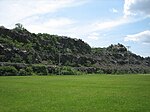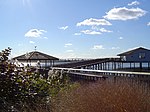Ackerman-Dewsnap House
Houses completed in 1837Houses in Bergen County, New JerseyHouses on the National Register of Historic Places in New JerseyNational Register of Historic Places in Bergen County, New JerseyNew Jersey Register of Historic Places ... and 3 more
New Jersey Registered Historic Place stubsSaddle River, New JerseyUse mdy dates from August 2023

Ackerman—Dewsnap House is a historic house at 176 East Saddle River Road in Saddle River, Bergen County, New Jersey, United States. The house was built in 1837 and added to the National Register of Historic Places on August 29, 1986.
Excerpt from the Wikipedia article Ackerman-Dewsnap House (License: CC BY-SA 3.0, Authors, Images).Ackerman-Dewsnap House
Geographical coordinates (GPS) Address Nearby Places Show on map
Geographical coordinates (GPS)
| Latitude | Longitude |
|---|---|
| N 40.762777777778 ° | E -74.103055555556 ° |
Address
Kearny
07032
New Jersey, United States
Open on Google Maps










